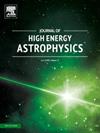X-ray flux variability of Blazar Mrk 501 observed using NuSTAR
IF 10.5
4区 物理与天体物理
Q1 ASTRONOMY & ASTROPHYSICS
引用次数: 0
Abstract
We present a detailed spectral study of 12 X-ray NuSTAR observations of the BL Lac object Markarian (or Mrk) 501, spanning a period from 2013 to 2022. We extracted source spectra within an 80-arcseconds radius around the source center and background with a radius of 300-arcseconds. The X-ray flux variability of our sample was derived by extracting the Blazar Mrk 501 sample spectra and fitting them with six models in the XSPEC package; these models yielded similar results. The spectral models covered various physical processes, including thermal bremsstrahlung emission. In addition, we investigated the time variations of the model parameters. By comparing the fits from the six models, we found that the zpowerlw model is the best representation of the data in the low state, while the bremsstrahlung-zpowerlaw model best represents the data across all energy ranges. To verify the X-ray variability of our data, we fit their spectra, extracted using the same method from the same instrument, with the same model to estimate their X-ray luminosity and flux. To verify the variability of the estimated fluxes, we fitted them using the bremsstrahlung-zpowerlaw model and found clear variability over the 12 observations. The bremsstrahlung-zpowerlaw model was the best model fitting the data in the 3 – 50 keV band. The highest variability was found in observation 60002024006, with a flux variability of 39.72 × (erg cm−2 s−1). While the lowest variability was found in observation 60466006002, with a flux variability of 1.34 × (erg cm−2 s−1), making the flux variability range 38.38 × (erg cm−2 s−1).
利用核星观测Blazar Mrk 501的x射线通量变异性
我们对2013年至2022年期间BL Lac天体Markarian(或Mrk) 501的12个x射线核星观测结果进行了详细的光谱研究。我们提取了源中心周围半径为80弧秒和背景半径为300弧秒的源光谱。通过提取Blazar Mrk 501样品光谱,并将其与XSPEC包中的6个模型拟合,得出样品的x射线通量变异性;这些模型得出了相似的结果。光谱模型涵盖了各种物理过程,包括热轫致辐射。此外,我们还研究了模型参数的时间变化。通过对6个模型的拟合比较,我们发现zpowerlw模型最能代表低能级的数据,而bremsstrahlong -zpowerlaw模型最能代表所有能级的数据。为了验证我们数据的x射线变异性,我们用相同的方法从相同的仪器中提取了它们的光谱,并用相同的模型来估计它们的x射线光度和通量。为了验证估计通量的可变性,我们使用韧应力-幂律模型对它们进行了拟合,并在12个观测值中发现了明显的可变性。对3 ~ 50kev波段的数据拟合最好的是韧应力-幂律模型。观测值60002024006的通量变异性最大,为39.72 × 10−11 (erg cm−2 s−1)。而观测值60466006002的变率最低,通量变率为1.34 × 10−11 (erg cm−2 s−1),因此通量变率范围为38.38 × 10−11 (erg cm−2 s−1)。
本文章由计算机程序翻译,如有差异,请以英文原文为准。
求助全文
约1分钟内获得全文
求助全文
来源期刊

Journal of High Energy Astrophysics
Earth and Planetary Sciences-Space and Planetary Science
CiteScore
9.70
自引率
5.30%
发文量
38
审稿时长
65 days
期刊介绍:
The journal welcomes manuscripts on theoretical models, simulations, and observations of highly energetic astrophysical objects both in our Galaxy and beyond. Among those, black holes at all scales, neutron stars, pulsars and their nebula, binaries, novae and supernovae, their remnants, active galaxies, and clusters are just a few examples. The journal will consider research across the whole electromagnetic spectrum, as well as research using various messengers, such as gravitational waves or neutrinos. Effects of high-energy phenomena on cosmology and star-formation, results from dedicated surveys expanding the knowledge of extreme environments, and astrophysical implications of dark matter are also welcomed topics.
 求助内容:
求助内容: 应助结果提醒方式:
应助结果提醒方式:


